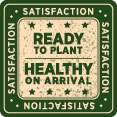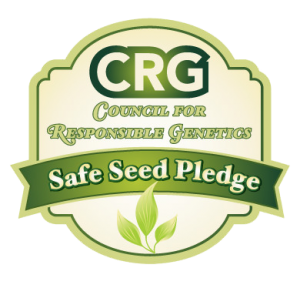Fall Vegetable Gardening
What we call “Fall Vegetables” are actually ones that do best when the weather is cooler and may actually be the same as many vegetables you would grow in the early spring or even in summer, depending on your climate. In northern areas, spinach, broccoli, peas and even cabbage may be grown during the summer months since you may not get above 85 degrees during that time. In southern areas, because we get above 85 very quickly, generally in May, we cannot grow these types during summertime but have to grow during shoulder seasons of early spring and late summer through fall. Shop for Fall Vegetables Now!
Timing for planting is crucial as each plant will have a certain number of days required for full maturity. In the case of leafy greens, this is not as important since you can harvest them early, but for flowering vegetables such as broccoli and brussels sprouts, you have to make sure that maturity happens before your first freeze in late fall. Our plants have these days to maturity listed in our catalog and there is a chart below that will give you rough guidelines for planting dates. The best way to determine when to plant is to enter your zip code in our Recommended ship date finder and all items will display their best recommended shipping date for your backyard.
How Do I Get My Garden Ready for Fall Planting?
Before you can plant anything new, you should do a simple soil test to make sure the pH is still up at above 6.0 If not, add 1 pound of lime per 100 square feet for each .5 below that number. Hydrated lime will work quickly to correct the pH for fall vegetables. Remove all of the dead plants that are no longer producing fruit. Most can go into the compost pile but any plant material that had diseases or insect problems should be disposed of to avoid carry over to the next season.
Add an inch or two of good rich compost and rototill the beds but make sure to remove any weeds carefully so that seeds are not spread out all over your garden. Any portion of the garden that is not going to plant until next spring should be covered well with hay or black plastic or you can plant a cover crop of clover or rye grass to turn under in the spring for additional nitrogen.
What Comes In, What Goes Out?
Broccoli, Brussels Sprouts, Spinach, Cauliflower, Peas, Lettuces and greens of all types can be grown in the Fall. Most are frost tolerant and some can withstand freezes and even snow on the ground. Cabbages can grow huge but live over until early spring. All types of Salad greens can be planted and harvested at various stages.
Even warm season plants such as Bush beans can be grown in a fall garden by planting early varieties in July or August; they will be able to produce beans before the first frost! Many bush bean varieties take only 50-60 days to mature.
Peppers generally ripen in the south very quickly in our hot dry months of August and September so leave them in the ground for as long as they are producing. Well watered plants will continue to fruit through the fall months. Peppers are also easy to freeze for storage and are great flavorings for soups when the weather is colder. After Peppers die back from the first frost, pull the plants out and set aside that area for Potatoes in early spring. Cover the row with a heavy layer of hay straw to begin to break down and lighten the soil.
Lettuces and Greens are full of nutrition and they will thrive with cooler nights and actually taste sweeter. Plant them while it is still warm and watch them get larger as the temperatures drop. Spinach, one of our favorites, can be grown in even the coldest areas, all winter long with a covering of special lightweight fabric placed over the plants. Carrots can also be grown during the fall months, pull what you need for vegetable soup and Thanksgiving dinner and leave the rest in the garden until you need them.
Garlic and Shallots are best started in the fall months, around September to mid October, and left to over winter. Spring will bring a harvest of huge bulbs ready to pull around late May to early June. Plant bunching or green onions in early fall and plan to harvest them in November leaving room for bulbing sweet onions to be planted in January – March.
Even if you do not plant fall vegetables it is a good idea to do the following steps to get your garden ready for next spring.
The Best Vegetables and Greens for Fall Growing
Healthy and Nutritious, greens are really the easiest vegetables to grow. You can even grow them with only a half day of sunshine or in containers with fantastic results. No staking, no pruning, no fuss and no bother.
Greens:
- Arugula
Fast growing leafy greens for salads or pizza or pastas. - Collards
Another leafy green similar to kale but with larger, stronger flavored leaves. - Kale
Very nutritious leafy greens on huge plants that over-winter easily even in cold climates. - Lettuces
Easy to grow in areas with milder winters, they will grow throughout the fall season and can be extended by covering with a light fabric. - Spinach
Delicious and sweet when the weather cools off, spinach will also grow through the winter under a light cover. - Swiss Chard
Very easy to grow and delicious to eat braised with a little garlic or in a soup or stew. Leaves can get quite large and will produce all winter long in mild areas.
Brassicas
- Broccoli Incredibly delicious when you grow your own. Broccoli grows a central flower head and continues with side shoots that can harvest after the main head is cut.
- Brussels sprouts Best from transplants these are wonderful little cabbages to grow. Check days to maturity for best results in your growing area.
- Cauliflower Cauliflower planting must be timed well in order to develop large heads but they are sweet and delicious when grown fresh.
- Cabbages Huge plants make good sized heads, watch for the number of days to maturity for best results.
More Fall Vegetables
- Beans and Peas
While not exactly winter crops, beans and peas love the cooler weather of fall and fast maturing varieties will grow and harvest before your first frost. - Beets
Easy to grow for the tops as greens or wait just 60 days and harvest the root for soups and stews. - Carrots
Easy to grow and will hold in the ground for weeks. - Radishes
Fast growing and so easy! - Bunching Green Onions
Easy to grow and long lasting, you will harvest them similar to large chives.
Hardy vegetables tolerate hard frosts (usually 25 to 28 degrees F). They are good for spring and fall gardens. The hardiest–kale, spinach, and collards–can tolerate temperatures in the low 20s and high teens. All of these vegetables taste best when they mature in cool weather, so they are very well suited to late summer planting for fall harvests. Harvest extends into winter in the Southeast, Southwest, and Pacific Northwest.
- Broccoli
- Brussels sprouts
- Cabbage
- Collards
- Peas
- Kale
- Parsley
- Radishes
- Spinach
Semi-hardy vegetables tolerate light frosts (usually 29 to 32 degrees F) late into fall and through winter in mild climates.
- Beets
- Carrots
- Cauliflower
- Celery
- Lettuce and salad greens
- Swiss chard
Fall Garden Conditioning
Preparing your garden for next year is very important. If done properly it allows you to use less chemical fertilizers and create a more loamy, light, soil with lots of microorganisms that will dig and digest organic material all winter long. This adds fertility to your garden that would have to be added in next spring at a slower and more expensive rate. For example, adding dead leaves to your garden makes for sweeter tomatoes next spring and provides better drainage at the same time. Here are some other mulching materials which can be added to your soil to improve the consistency and fertility:
- Dead Leaves
- The more the better, pile them on!
- Old Hay Straw
- Watch out for seeds in hay
- Compost from Grass, Kitchen and Garden Clippings
- Half dried and half green, not too much green stuff
- Worm Castings
Good black compost made rich by worms - Pine Needles
- Make sure you add lime to correct the Ph as these can make your soil more acidic
- Cottonseed Meal
- Egg Shells
- These add calcium which is needed by vegetables
- Manures
- Horse, cow, chicken or rabbit, no more than a inch or two depending upon the animal
- Green Manures
- Green manure is actually just plants which grow well during the off season and dig down deeply with their roots, then are turned under in spring to breakdown before planting. This type of composting creates organic material in the soil, does deep digging for you, and can even add nitrogen if you use bean type (legume) plants. Red Clover and Annual Rye grass will grow in the winter months and when turned under, will release nitrogen as it breaks down.
- Lime
- To correct pH in heavy rainfall areas, lime is almost always needed every year. Most importantly, old gardeners know never to leave the soil uncovered for the weeds to take over and soil to compact.
Use natures direction and get those raked leaves back into the soil or compost heap and out of those plastic bags!
You can view this map below which will indicate your average first frost date in fall.
Check our map for your average first frost date and calculate your best planting dates for these vegetables in the chart:



